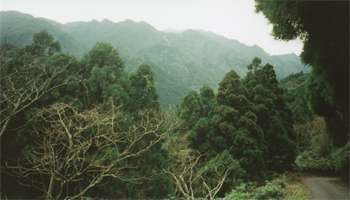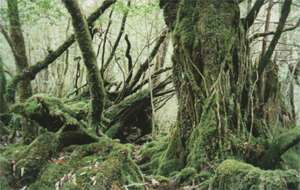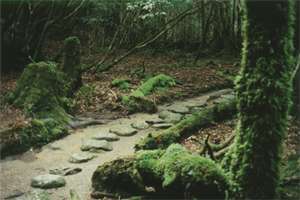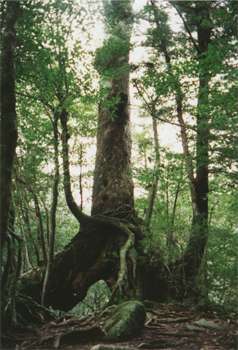My trip begins with the walk to Takanohara-eki (station), obsessing over the damn pair of scissors I forgot to take out of my jacket pocket and now have to carry for the next week. After all the agonizing over how to reduce weight [Should I take the binoculars or leave them behind? If I take the APS camera I might miss a good shot. If I take the 35mm it might not work in the ice. If I take both I have to carry them... and more types of film. What should I do? Do I really need my cutlery-set knife if I have my pocket knife? How many packets of noodles can I cram into a billy if I crush them up? Will I need the thermal socks or just Explorers?] I have these stupid useless scissors with me. Such is the way. I'll skip the bus trip with the funny girl's voice on the PA and get on with it...
After a slight muddle at the Oh-saka (Osaka) airport in which the baggage check-in folks wouldn't let me take my ice axe as carry-on luggage, wouldn't let me pass the metal detector with my boots on (they had to go through the X-ray and I had to stumble around in little tartan slippers whilst they went through my carry-on bag), wouldn't let me take my pocket knife in my pocket... well OK, the axe and the knife were understandable... but the boots? I finally jumped on my flight (boots re-laced), to the Deep South... Kagoshima in Kyushu.
The sun was out and actually warmed me (a first this year in Japan!) as I crossed the tarmac from the Kagoshima terminal to the little turbo-prop and climbed the ladder to Yakushima. I had seat 2A.

The meal on this toy aeroplane was kosher, but not very filling... one little barley sugar... but the smile this came with was worth ichi-man en! Not too many girls on this planet have a smile like that. Fortunately, I think I now know all of them, and some with kyu-man en smiles. Of course we landed safely on a runway by the beach (the only flat area) of Yakushima. Its now time for a tourist information brochure reading....
Yakushima is a roughly circular island about 24 km's in diameter. It lies 40 minutes by air off the South Coast of the Southern-most main island of Japan (Kyushu) and has a semi-tropical climate. Despite its small size, it includes the highest mountain in Southern Japan. Miyanoura-dake (Miyanoura peak) tops out just below 2000 meters... whilst this is a trifle compared to the Japanese Alps, most climbs in the Alps do not start at a sea-level airport. The Alps are also not contained on a tiny island (unless you count Japan as a tiny island, which it is by Australian standards) and so there is plenty of time to climb up them. This was not going to be a walk in the park.
Yakushima's peaks were largely covered in haze. I think this is fortunate. I might have turned around and gone home had I seen in advance what I was in for. The coastal region was toasty warm and humid. I pulled off my fleece at the airport door, grabbed my pack and pocket knife (which came safe and sound in a special little envelope) and headed over the road to fill my stove with petrol. The attendent here knew the island and its trails thoroughly. He gave me some advice and chatted with me about possible routes before waving me on my way. A friendly hitch-hike later and I was at the road to the trail head. Here I go!

A little dog ran from its master's farm to follow me on the road, barking incessantly. It kept its distance so I let it follow behind. Its master was running up the road behind it, puffing and calling out. I have forgotten the dog's name. I tried hard to remember it but it slipped from my mind as the animal slipped back down the road.
The bitumen finally stopped and became a gravel track as I passed the signs marking the trail head. Tree ferns and weeds lined the way as the gravel became a concrete channel! Ughhhh.... please NO! This can't be happening! I didn't come all this way to walk up a concrete path. The concrete wound its way on and on. I was in tears of frustration. This is appalling. I was so furious I could have turned back and come home right then and there... Yakushima is one of the WETTEST places in Japan. Its annual rainfall would be enough to fill a decent swimming pool with ease... but do they really need to use concrete to stop the path from washing away? Surely something better could be organized.
My disappointment did not last longer than the first half hour. The slope increased and the path turned once more to gravel. Eventually, as the first sections of real forest arrived and the pylons and wire of the "cultural zone" fell away, my feet welcomed soft mossy soil Ð just the stuff to let my poor abused sole(s) (soul) tread in comfort. A brief turn to look back at the sea, now far below me in the mid-afternoon haze. A glance upwards at the immensely steep peaks just visible in the mist. A step, and I vanish into the trees.
Boy its dark in here! Its also not quite as warm as it was a few paces back. As my eyes adjust to the light I rub them a few extra times. Is this place for real? These roots twist and turn like fingers clutching a boulder, ready to hurl it down the steep mountainside. This moss? Surely it can't be natural? It glows in the dim light. What am I seeing?


The light is fading fast as I trundle along the stone path, glancing occasionally at the yellow plastic GPS, its screen glowing steadily. This thing is from another universe. At least I won't lose it! The first hut isn't far now. Hang on a minute. Is that a tree? You have got to be kidding, they don't make trees like that...
You can tell a lot about people by the trees that live with them. The first trees I encountered en-mass in California last July were the Joshua trees. Their crazy Seussian twists evidently an indication of the local human character. The next trees were the upright, grand, prickly and somewhat peculiar saguaro cacti. I will leave you to draw conclusions from this about the Mexicans and inhabitants of South Arizona. The other notable plant I encountered in the USA was of course the Sequoia. These immense trees are elegant, noble and powerful, but they are shallow-rooted and despite their grandeur prone to topple over. Nevertheless, Sequoia manage to survive for many thousands of years in isolated pockets of Californian wilderness despite being visited by several million wide-eyed, bus-sitting, ice-cream-stuffing, tea-towel buying tourists and their megaphone-wielding manical tour guides. The Sequoia are exceedingly beautiful trees to behold. He who walks humbly beneath the Sequoia learns many things. He who rides by the Sequoia in a bus, gawking out the window because he is too lazy to get off his arse and doesn't want to get his Nike's dirty is not my friend.
So what stood above me in this ancient Japanese wonderland? I was standing beneath a sugi, a cedar. Not tall and graceful as the Sequoia, twisted and gnarled, as if suffering from the effects of its age. As I wandered in the increasing darkness these trees loomed over me, their twisted limbs each more heavy than even the most weighty trunks standing around them. These Ent-like beings were to become great travelling companions over the next few days.
I waltzed merrily into a re-entrant with a stream tumbling in silver flashes along its rocky channel. Stopped. In. Awe. I'm sure you know the kind of re-entrant I am referring to. Sheltered utterly by the hills to either side, littered with boulders exposed by tumbling water. Fallen tree trunks and limbs criss-cross the narrow channel, midori (green) with tree ferns and moss, fresh with the smell of wet earth. These places are amongst the most beautiful in any forest. This quiet, dim recess was nothing short of miraculous. Could a place ever be more exquisitely arranged?
A boulder the size of a living room was nestled ahead in thick luminous moss. Upon its upper surface grew a mass of inter-twined trees. Roots spread across the curvaceous stone and down into the bed like delicate, muscular pythons intent on devouring a giant egg. A stream flashed in the dim light, across slick polished marbles, under glistening weathered tree limbs and through a web of twisted timber toes.

Up and up the path continued through this marvelous creature. As darkness set more firmly, a sugi appeared blacker than the forest in front of me. Its roots were forked wide across the path where once lay its toppled ancestor, now decayed but living on in this negative space through which I might pass.
A white sign glows gently... hut in 5 metres? I peer into the void. I wave my hand in front of my face, at least I think I did. Up and down I stumble to a quick-silver ripple in a void. Using my trekking-pole to aid me in my blindness I cross safely. My feet hit the porch of the concrete hut which is to be my night's rest. How can one build a concrete shelter in a place like this and sleep soundly at night? Torchlight reveals that the forest does its utmost to reclaim the space. In its own time it is laying a carpet of moss on the walls and roof. The cement bricks of the seventies flicker in the glow of my stove. The hard pale walls are silhouetted against the black forest.